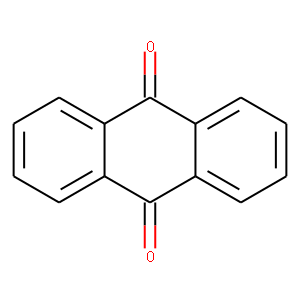| Reference | <div>
1. J Zhejiang Univ Sci B. 2019 Jun;20(6):528-540. doi: 10.1631/jzus.B1900165.Bacterial degradation of anthraquinone dyes.Li HH(1), Wang YT(1), Wang Y(1), Wang HX(2), Sun KK(2), Lu ZM(2).</div>
<div>
</div>
<div>
Anthraquinone dyes, which contain anthraquinone chromophore groups, are the second largest class of dyes after azo dyes and are used extensively in textile industries. The majority of these dyes are resistant to degradation because of their complex and stable structures; consequently, a large number of anthraquinone dyes find their way into the environment causing serious pollution. At present, the microbiological approach to treating printing and dyeing wastewater is considered to be an economical and feasible method, and reports regarding the bacterial degradation of anthraquinone dyes are increasing. This paper reviews the classification and structures of anthraquinone dyes, summarizes the types of degradative bacteria, and explores the possible mechanisms and influencing factors of bacterial anthraquinone dye degradation. Present research progress and existing problems are further discussed. Finally, future research directions and key points are presented.</div>
<div>
</div>
<div>
2. Biomolecules. 2019 Feb 18;9(2):68. doi: 10.3390/biom9020068.Chrysophanol: A Natural Anthraquinone with Multifaceted Biotherapeutic Potential.Prateeksha(1)(2), Yusuf MA(3), Singh BN(4), Sudheer S(5), Kharwar RN(6), Siddiqui S(7), Abdel-Azeem AM(8), Fernandes Fraceto L(9), Dashora K(10), Gupta VK(11).</div>
<div>
</div>
<div>
Chrysophanol is a unique anthraquinone having broad-spectrum therapeutic potential along with ecological importance. It is the first polyketide that has been reported to be biosynthesized in an organism-specific manner. The traditional Chinese and Korean medicinal systems provide evidence of the beneficial effects of chrysophanol on human health. The global distribution of chrysophanol encountered in two domains of life (bacteria and eukaryota) has motivated researchers to critically evaluate the properties of this compound. A plethora of literature is available on the pharmacological properties of chrysophanol, which include anticancer, hepatoprotective, neuroprotective, anti inflammatory, antiulcer, and antimicrobial activities. However, the pharmacokinetics and toxicity studies on chrysophanol demand further investigations for it to be used as a drug. This is the first comprehensive review on the natural sources, biosynthetic pathways, and pharmacology of chrysophanol. Here we reviewed recent advancements made on the pharmacokinetics of the chrysophanol. Additionally, we have highlighted the knowledge gaps of its mechanism of action against diseases and toxicity aspects.</div>
<div>
</div>
<div>
3. Pest Manag Sci. 2016 Oct;72(10):1813-25. doi: 10.1002/ps.4330. Epub 2016 Jul 7.Review of anthraquinone applications for pest management and agricultural crop protection.DeLiberto ST(1), Werner SJ(1).</div>
<div>
</div>
<div>
We have reviewed published anthraquinone applications for international pest management and agricultural crop protection from 1943 to 2016. Anthraquinone (AQ) is commonly found in dyes, pigments and many plants and organisms. Avian repellent research with AQ began in the 1940s. In the context of pest management, AQ is currently used as a chemical repellent, perch deterrent, insecticide and feeding deterrent in many wild birds, and in some mammals,insects and fishes. Criteria for evaluation of effective chemical repellents include efficacy, potential for wildlife hazards, phytotoxicity and environmental persistence. As a biopesticide, AQ often meets these criteria of efficacy for the non-lethal management of agricultural depredation caused by wildlife. We summarize published applications of AQ for the protection of newly planted and maturing crops from pest birds. Conventional applications of AQ-based repellents include preplant seed treatments [e.g. corn (Zea mays L.), rice (Oryza sativa L.), sunflower (Helianthus annuus L.), wheat (Triticum spp.), millet (Panicum spp.), sorghum (Sorghum bicolor L.), pelletized feed and forest tree species] and foliar applications for rice, sunflower, lettuce (Lactuca sativa L.), turf, sugar beets (Beta vulgaris L.), soybean (Glycine max L.), sweet corn and nursery, fruit and nut crops. In addition to agricultural repellent applications, AQ has also been used to treat toxicants for the protection of non-target birds. Few studies have demonstrated AQ repellency in mammals, including wild boar (Sus scrofa, L.), thirteen-lined ground squirrels (Ictidomys tridecemlineatus, Mitchill), black-tailed prairie dogs (Cyomys ludovicainus, Ord.), common voles (Microtus arvalis, Pallas), house mice (Mus musculus, L.), Tristram's jirds (Meriones tristrami, Thomas) and black rats (Rattus rattus L.). Natural sources of AQ and its derivatives have also been identified as insecticides and insect repellents. As a natural or synthetic biopesticide, AQ is a promising candidate for many contexts of non-lethal and insecticidal pest management. Published 2016. This article is a U.S. Government work and is in the public domain in the USA.</div>
<div>
</div>
|

